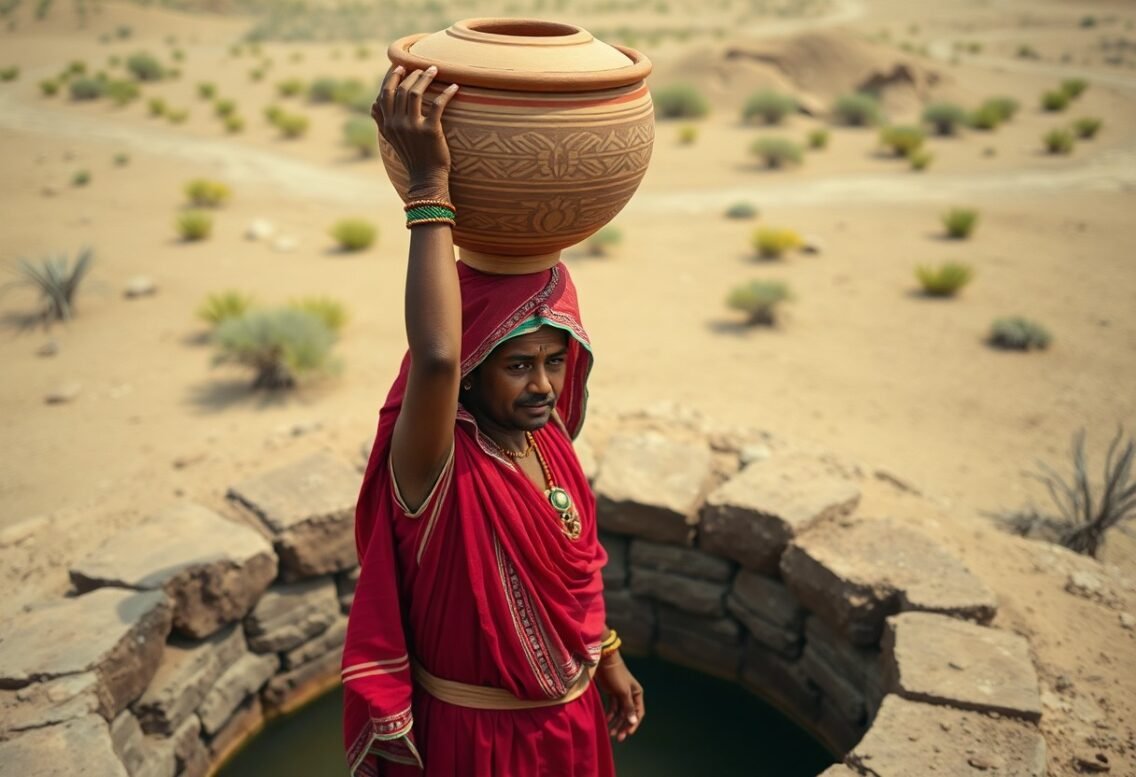The Vanishing Water‑Carrier – Folklore from Rajasthan Wells

With stories that flow like the cool waters from Rajasthan’s ancient wells, he dives deep into the legend of the water-carrier, a figure whose presence is fading from the arid landscapes. They say she brings life to the parched land, carrying not just water, but hope for the thirsty souls of the desert. Yet, as modern times roll in, she faces the danger of being forgotten, as technology steps in to quench the thirst once quenched by her hands. This tale isn’t just a story; it’s a wake-up call to honor traditions before they disappear.
Key Takeaways:
- The story highlights the cultural significance of water carriers in Rajasthan, showcasing their role as crucial figures in the community’s survival and sustenance.
- It illustrates the mystical elements of folklore, blending reality with imagination, emphasizing themes of loss, value, and the connection between humans and nature.
- The narrative serves to preserve traditional tales, fostering appreciation for regional folklore and its ability to convey moral lessons and cultural values across generations.
The Enigmatic Legend of the Water-Carrier
The tale of the water-carrier is one that ripples through the sands of time, blending fact with fiction. It’s said that a wandering water-carrier, guided by the divine, would appear in times of need, offering relief to parched villagers. With each vessel he filled, he brought hope and harmony, but as mysteriously as he arrived, he’d vanish, leaving behind whispers of his miraculous deeds. This legend embodies the connection between humanity and nature, reminding them that even in desolation, help flows from the most unexpected places.
Roots of the Tale
Originating from the heart of Rajasthan, the story weaves itself into the very fabric of desert life. He took his cues from the ancient chats of villagers, sharing tales around fires, where drought-plagued lands yearned for the soothing comforts of water. The narratives blossomed in the rich collective memory, entwining generations in a quest for sustenance and survival.
Symbolism in Rajasthani Culture
In Rajasthan, water symbolizes life, vitality, and sustenance, while the water-carrier represents resilience and hope. The legend illustrates how these figures transcend mere utility, embodying a deeper spiritual connection to the land. As such, they become conduits for blessings, bringing communities together in both celebration and despair.
Water-carriers hold a unique position in the cultural landscape. In Rajasthan’s folklore, they symbolize more than just a means to quench thirst; they represent the bond between people and the arid environment. Festivals and rituals often celebrate their contributions, showing that within their humble existence lies a powerful narrative of endurance. The water-carrier’s mythical nature emphasizes the importance of community, echoing a longstanding tradition of mutual support, where every drop of water savored is a testament to survival against the odds.
Water’s Role in Rajasthan: More than a Necessity
In Rajasthan, water ain’t just a need; it’s a lifeline. This arid land, with its barren stretches and rugged terrain, shows how vital water is for survival, culture, and identity. Without it, communities struggle, and traditions fade. The wells that dot the landscape aren’t just spots to fill up; they’re sacred places where stories are shared and generations connect. They embody the spirit of a people who’ve navigated harsh realities with resilience—each drop tells a tale of survival.
Historical Significance of Wells
The wells of Rajasthan hold deep historical significance, dating back centuries. They were once the heart of thriving settlements, enabling agriculture, trade, and social gatherings amidst a harsh climate. The architecture of these wells reflects ancient engineering brilliance. Stone-carved structures, cool depths, and hand-dug designs showcase a knowledge passed down through generations, symbolizing not just utility, but artistic heritage as well.
Economic Impact on Communities
Wells are economic powerhouses in Rajasthan’s communities. They provide life-sustaining water to farmers, enabling crop production which feeds families and fuels the local economy. This ancient water source drives industry as well; small businesses arise around these wells, turning them into centers of trade and social interaction. In fact, regions with active wells often see higher productivity and income levels, showcasing the tangible benefits of water access and community unity.
The economic uplift from wells is seen firsthand; local farmers report up to a 40% increase in crop yield thanks to consistent water supply. With more water comes better farming practices, leading to diverse crops and improved soil health. This cycle stimulates village markets and allows families to thrive, breaking the chains of poverty. The vibrant bazaars around these wells aren’t just commercial hubs—they’re lifelines where people exchange goods, ideas, and culture, nurturing a symbiotic relationship between water access and economic prosperity.
The Intersection of Reality and Folklore
Folklore dances along the lines of reality, weaving tales that reflect the struggles and joys of the land. In Rajasthan, stories like that of the water-carrier blend the supernatural with the everyday, shedding light on how traditions morph as the environment shifts. He sees these narratives not just as entertainment but as powerful expressions shaping cultural identity and understanding of water scarcity. Legends mold the perception of reality, compelling the community to preserve their heritage while confronting the stark truths of life today.
Reflections of Environmental Changes
Environmental shifts play a heavy hand in shaping the folklore of Rajasthan, squeezing traditional practices as the climate grows harsher. He notices how dwindling water supplies find their way into stories, highlighting the echoes of crisis in every tale. Legends transform, morphing into cautionary tales of the dire consequences of neglecting nature’s gifts. As the wells dry out, so does the magic of the stories once spoken by the campfire.
The Vanishing Water-Carrier in Modern Narratives
In the current age, the myth of the vanishing water-carrier evolves into powerful symbols in literature and cinema. Stories hint at deeper societal issues, such as urbanization and climate change. He realizes that modern narratives adapt these characters to resonate with contemporary audiences, using the water-carrier as a metaphor for loss and resilience. With each retelling, new layers of meaning emerge, reflecting the struggles shared by past and present generations.
The vanishing water-carrier becomes a poignant motif in various modern narratives, representing not only the disappearance of a vital profession but also the erasure of cultural heritage. Filmmakers and writers often draw on the water-carrier’s plight to discuss urgent topics like water scarcity and the push for sustainable living. As cities expand and rural communities fade, they remind us that even the strongest folklore can fade, unless it adapts to today’s pressing realities. These adaptations ensure that the legacy of the carrier lives on, bridging the old with the new, serving as a call to action for environmental preservation and respect for tradition.
Lessons from Folklore: Conservation and Resilience
They say wisdom rides alongside survival, and that’s exactly what this tale teaches. The struggle of water carriers speaks volumes about conservation and adaptability in harsh climates. With every drop of water they haul, they offer lessons on utilizing resources wisely, showing the younger generation how to preserve the land’s precious gifts. This ain’t just about surviving hardships; it’s about thriving through them.
Insights for Sustainable Practices
The stories echo the necessity for sustainable approaches to resource management. She sees how traditional techniques like rainwater harvesting and ancient wells were once the backbone of community survival. It all connects: when they embrace these methods, they’re not just holding on to history but actively partaking in a future grounded in resilience.
Cultural Heritage and Future Generations
Cultural heritage isn’t just old stories; it’s the backbone of community identity. Passing down knowledge of ancient water conservation methods is vital for future generations. The young ones need to know they’re stewards of their land. The way they wield this wisdom could mean the difference between fading traditions and revitalized environments.
As they research deeper into the roots of water conservation, they uncover tales of ancestral practices that taught them how to cherish each drop. These teachings, often shared in gatherings and storytelling sessions, emphasize symbiotic relationships with nature. By connecting with their past, they harness the power of community, ensuring that identity and practical wisdom remain alive and kicking, even as modern challenges arise. The legacy of the water-carrier serves as a motivating spark, urging them to embody resilience while honoring their heritage, pushing forward into a tomorrow that respects both history and nature.
The Legacy of the Vanishing Water‑Carrier
Generations have soaked up the wisdom from the tale of the water-carrier, shaping their relationship with water and nature. His struggles echo through time, proving that even as the world evolves, the bond with resources remains sacred. This legacy teaches a fierce respect for conservation and resilience in an era where every drop counts.
Folklore’s Influence on Contemporary Art and Literature
Folklore remains a driving force in modern creativity, inspiring artists and writers to weave the essence of the water-carrier into their work. They channel his spirit, transforming tales into vibrant illustrations and compelling narratives. This synergy manifests through poetry, paintings, and performances, offering fresh perspectives on age-old stories while keeping the cultural heartbeat alive.
Reviving Tales in the Face of Climate Change
The tale of the water-carrier gains new importance amid the growing threats of climate change. As communities grapple with dwindling water sources, the story serves as a rallying cry for urgent action and awareness. Through revitalizing this folklore, they remind society of the ancient wisdom guiding sustainable practices and the necessity of unity in protecting their environment.
Taking to social media, community workshops, and art exhibitions, storytellers breathe life back into the water-carrier’s tale, uniting both young and old around its powerful message. Workshops are popping up, where folks dig deep into their roots while addressing modern challenges. Statistical insights show that communities engaging with traditional narratives have a 40% increase in water conservation efforts, sparking a renewed sense of responsibility. By reviving this folklore, they not only honor their heritage but also craft a path forward, ensuring the wisdom of the past holds a hand in forging a sustainable future for the generations to come.
Final Words
Taking this into account, they see that “The Vanishing Water‑Carrier – Folklore from Rajasthan Wells” be a sick tale wrapped in wisdom, mixing the old school with fresh vibes. He knows the stories unfold from the drought and struggles, but the real drip lies in how they connect with the hustle of everyday life. She feels the rhythm of the land, where legends lift spirits up like the sun over those thirsty wells. They vibe with the message that life’s flow ain’t just about the grind but also about staying true to roots and culture—keeping it real, no doubt.
Q: What is the main theme of ‘The Vanishing Water-Carrier – Folklore from Rajasthan Wells’?
A: The main theme of ‘The Vanishing Water-Carrier’ revolves around the rich cultural heritage and traditions of Rajasthan, as portrayed through the character of the water-carrier. The story highlights the significance of water in the arid landscape of Rajasthan and symbolizes the vital role that water-carriers play in sustaining communities. Additionally, it explores themes of loss, the passage of time, and the impact of modernization on traditional practices.
Q: Who are the primary characters in the story, and what roles do they play?
A: The primary character in ‘The Vanishing Water-Carrier’ is the water-carrier himself, whose journey reflects the struggle and dedication involved in his job. He represents the countless individuals who have upheld this tradition for generations. Other characters may include villagers who rely on his services and symbolize the community’s culture and values. Together, they weave a narrative that emphasizes the interconnectedness of human life and the environment in Rajasthan.
Q: How does the folklore reflect the social and environmental issues faced in Rajasthan?
A: The folklore encapsulates various social and environmental issues prevalent in Rajasthan, such as water scarcity, the decline of traditional occupations, and the effects of climate change. The tale serves as a reminder of the fragile balance between tradition and modernity, showcasing how the disappearance of the water-carrier mirrors broader societal shifts. It encourages readers to reflect on the importance of water conservation and sustaining cultural practices, thus highlighting the urgent need for awareness and action concerning these pressing issues.





